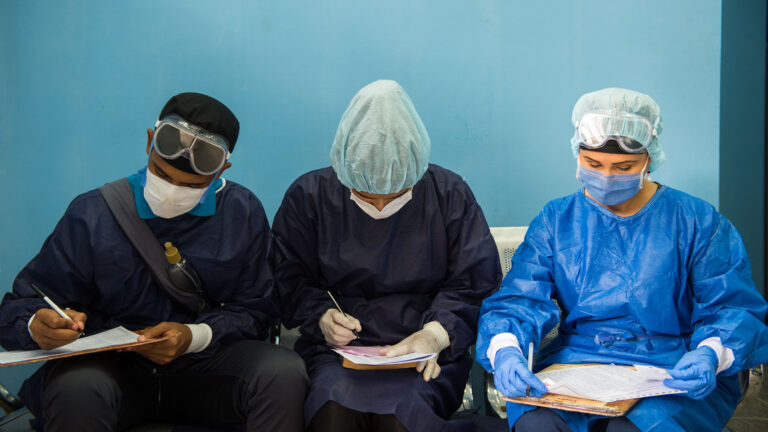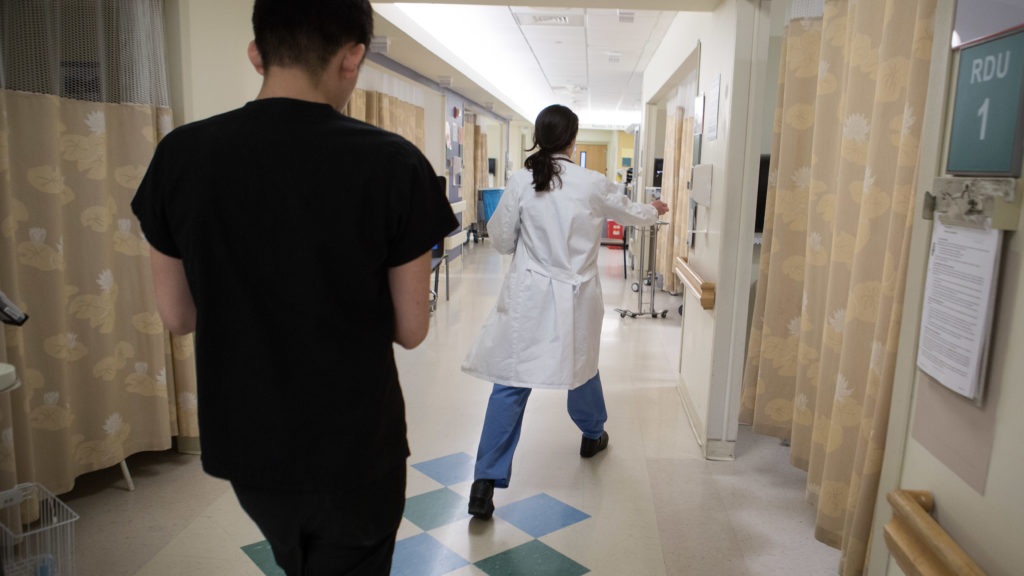Two decades ago, when I first began practicing emergency medicine, patient documentation was a manual process. I would write on carbon-copy forms that were later stored in the belly of the hospital, in archives, as patient files. To get a lab test, an X-ray, or a medication for a patient, I had to jot down instructions on a piece of paper, track down the right nurse, and verbally convey what orders I had put in. Phones were not smart and the fax machine was still a cornerstone of communication in the department. Every task required leg work and time.
The advent of electronic health records dramatically improved workflow. Suddenly, what once took multiple steps could be completed with a few clicks. But, as providers, our eyes became glued to the screens that aided us. We juggled typing orders and medical notes while speaking to patients. Physically, we turned our backs to our patients and our faces to the glowing digital workflows in front of us.
So, many emergency departments turned to medical scribes. These trained professionals would document patient encounters. Their presence was associated with an increase physician productivity, particularly during primary consultations, where productivity was noted to increase by 25.6% according to a multicenter randomized trial published in the British Medical Journal.
Most importantly, having a scribe meant I had more quality time with my patients.
Now, AI-driven ambient listening technology is taking the concept of medical scribes a step further. Instead of relying on a person to document every word and action, AI can capture and transcribe doctor-patient interactions in real time, without additional personnel.

Every doctor is a writer: On the end of note-writing and meaning-making in medicine
Today, when I walk into a patient’s room, I no longer carry a pen and paper or have a scribe in tow with their laptop. My smartphone, equipped with ambient listening technology, captures the conversation.
In the state where I practice, only one-party consent is required to record. Still, I introduce the process to patients: “I’m using a tool that helps document our conversation so I can focus entirely on you — is that OK?” So far, no one has declined. Patients understand that documentation is a necessary part of the medical visit — one way or another, the chart must be completed. Many seem to appreciate that this AI-assisted approach allows for a more natural, face-to-face interaction — free from the distraction of a provider typing on a computer or scribbling notes during the visit. By the time I return to my desk after evaluating several patients, drafts of all my notes are waiting for me — ready for editing and finalization.
I have used this system for almost a year, though I was a slow adopter, turning to it only intermittently at first. When my hospital phased out medical scribes, I dictated my notes, believing that to be faster than the AI-driven system. I initially reserved ambient listening for straightforward cases — the ones I trusted the software to handle accurately. Early on, the process also involved an extra step: copying the note from an external platform into the medical record, a clunky workaround that did not appeal to me. But recently, a fully integrated version was introduced, embedding ambient listening directly into the electronic health record. Once I began using this seamless system, I became a believer.
The benefits of this technology are clear — it is fast, efficient, and allows for more time at the bedside, focusing on what matters most: the patient. But, like all technologies, it is not without its limitations. AI does not always transcribe conversations flawlessly, and the generated notes sometimes require thoughtful editing. In my experience, however, the challenge is not usually one of factual inaccuracy. When AI listens, it tends to get the story right. The issue is more often one of clinical emphasis — a matter of accurately identifying which elements of the encounter warrant greater attention, particularly in emergency medicine, where the ability to spotlight what is most immediately life- or limb-threatening is critical. I have found that the solution is surprisingly simple: providing clear, verbal summaries to both the patient and the ambient listener.
In fact, the system excels at capturing these summaries. Importantly, when I take the time to reiterate a patient’s narrative and outline the treatment plan, I ensure that both the patient and I have a shared understanding of the next steps. I articulate these summaries more deliberately because I know AI is listening. It makes for a better note. However, the real benefit, I find, is the detailed and formalized understanding between patient and doctor. I am able to achieve a new level of clarity and mutual agreement in every patient encounter.

AI scribes are mostly rescuing doctors from themselves
Looking to the future, AI-driven ambient listening technology in health care could evolve in ways that anticipate clinical needs. For instance, AI might analyze my verbal synopsis and automatically generate relevant order sets, identify necessary consultations, or even recommend patient comfort measures. These capabilities could streamline workflows further, reduce cognitive load, and give me and my colleagues more time to focus on direct care. Such a progression would naturally mirror the role of traditional medical scribes, who not only documented encounters but also performed various clerical tasks to support physicians.
Whatever lies ahead, it is essential to approach any AI integration thoughtfully, ensuring that AI complements, rather than replaces, clinical judgment. I think of the AI-generated note as a draft written by a highly attentive but inexperienced student: It captures the essence of the story but sometimes misses the hierarchy of urgency that emergency medicine demands. I have never found errors that were dangerous or misleading, but I often revise the structure or emphasis to better reflect what is most clinically important. In that way, AI becomes a helpful partner — listening, drafting, even prompting — but still requiring the physician to shape the final narrative.
For now, for me, the promise of AI-driven ambient listening technology is simple and immediate: It allows me to be more present with my patients and their families.
Iyesatta Massaquoi Emeli, M.D., M.P.H., is a distinguished physician and assistant professor in emergency medicine at Emory University.
